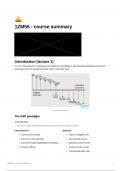Samenvatting
Extended Summary: Service Innovation Management / Servitization and Customer Experience (1ZM11)
- Vak
- Instelling
This is an extended summary of all lectures for the course Service Innovation Management (1ZM55). The new name of this course is Servitization and Customer Experience. This 55-page document summarizes the essence of all topics covered in the course (as far as I could imagine when writing it). It in...
[Meer zien]






